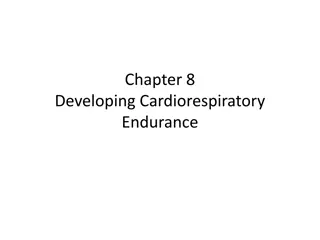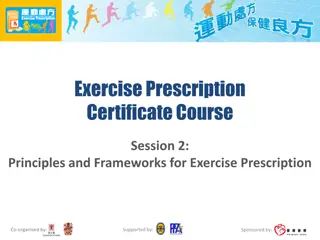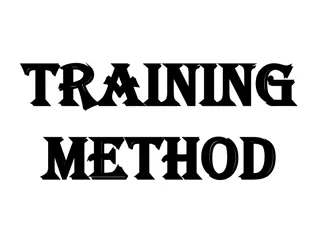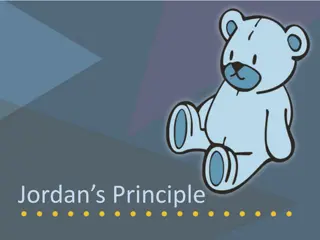Effective Application of FITT Principle for Muscular Strength and Endurance Training
Utilize the FITT Principle to design a workout plan for enhancing muscular endurance and strength. Understand the frequency, intensity, time, and types of exercises needed for optimal results. Modify and adjust elements regularly to prevent plateaus and overuse injuries. Focus on FIIT and injury prevention to ensure proper recovery. Achieve a well-rounded workout routine that challenges, engages, and brings success while prioritizing rest and recovery.
Download Presentation

Please find below an Image/Link to download the presentation.
The content on the website is provided AS IS for your information and personal use only. It may not be sold, licensed, or shared on other websites without obtaining consent from the author. Download presentation by click this link. If you encounter any issues during the download, it is possible that the publisher has removed the file from their server.
E N D
Presentation Transcript
MUSCULAR STRENGTH & ENDURANCE LEQ: CAN I APPLY MY KNOWLEDGE OF THE FITT PRINCIPLE TO DEVELOP A MUSCULAR ENDURANCE AND STRENGTH WORKOUT PLAN?
FITT PRINCIPLE Used to structure exercise, track progress, and achieve fitness goals Guideline for creating, revising, and maintaining a workout plan F= frequency: number of days I = intensity: amount of effort & energy T = time: duration of exercise session T = types: activities performed during session
USE FITT Manipulate training programs to improve health, fitness, and performance. Modify or adjust elements of FITT to avoid boredom, overuse injuries, and plateaus Switch up: Frequency by adding another day of movement Intensity by changing your pace or resistance Time by exercising for longer blocks of movement Type by engaging in a variety of movement opportunities
MODIFY AND ADJUST Changing one element can make a big difference in your workout and how the body responds to exercise. Switching things up on a regular basis keeps the body healthy and mind engaged.
FIIT & INJURY PREVENTION Monitor frequency, length, and intensity of workouts to ensure proper rest and recovery. Too much stress on the body increases risk of overuse injuries, burnout, or muscle strains. Add variety to workouts to allow different parts of your body to rest and recover .
FITT is a well-established way to modify and adapt exercise programming to fit unique goals, needs, lifestyle, preferences, and progress. The perfect workout plan is the one that brings YOU challenge, success, enjoyment, and engagement. THE FITT PRINCIPLE
CARDIORESPIRATORY ENDURANCE MUSCULAR STRENGTH MUSCULAR ENDURANCE FLEXIBILITY F 3-5 days a week 2-3 days a week 2-3 days a week 5-7 days a week (Frequency) I Moderate to vigorous 60-85% of Max Heart Rate Moderate to vigorous Moderate to vigorous Mild or light (Intensity) 20-40 minutes 8 to 10 exercises 2-5 sets of 2-8 reps Strength training with machine or free weights targeting major muscle groups Chest/Back Biceps/Triceps Shoulders Quads/Hamstrings Glutes Abs/Core 20-40 mins 8 to 10 exercises 2-3 sets of 12-20 reps Resistance tubes, medicine ball, body weight exercises HIIT Training Circuit Training Interval Training Tabata EMOM AMRAP Plyometrics T 20-60 minutes 10-30 minutes (Time) Running Swimming Cycling Aerobic classes Active Sports Elliptical Circuit Training Interval Training Plyometrics Dynamic Stretch Static Stretch Yoga Pilates Ballet Gymnastics Dance Cheer Wrestling T (Type)
MUSCULAR STRENGTH MUSCULAR ENDURANCE Heavy weight Low reps Longer rest and recovery time Builds strength & muscle mass Reduces risk of injury Lift or move heavy things without undue fatigue Light weight High reps Shorter rest and recovery time Builds endurance Reduces fatigue Improves posture, performance, sleep, and heart health
Muscular Strength Amount of forcea muscle group can produce in one, all-out effort (1-rep max) Well-balanced strength training routine targets all major muscle groups reducing risk of injury
Strength Training Exercises Upper Body Bicep curls, hammer curls, concentrated curl Triceps extension, kickback, dips, skull crusher Arnold/shoulder/military press, lateral/front raise Push-ups, chest press, chest fly Bent over row, pull ups, rear fly, lat pull down/over Upright row Lower Body Core Strength Plank Bird dog Dead bug Bicycle Hollow hold Glute bridge Superman Swimmers Wood chop Halo Squat Lunge Deadlift Clean Step ups Box jumps Hip thrust Calf raise
Muscular Endurance Muscle s ability to continuously contract against a given resistance without fatigue over time. Body weight exercises or low weight, high rep exercises
BODY WEIGHT EXERCISES Running, hiking, or walking Squats Push-Ups Crunches Calf Raises Swimming, dancing, jumping rope Planks Lunges Triceps Dips Mountain Climbers
MUSUCLAR STRENGTH MUSCULAR ENDURNACE FREQUENCY 2-3x s a week working different muscle groups 2-3x s a week or daily for some muscle groups INTENSITY 2-5 sets of 2-8 reps 8 to 10 exercises 2-4 sets of 12-20 reps 8 to 10 exercises TIME 15-60 mins Progressive overload 15-60 mins Progressive overload TYPE Resistance training with machine or free weights Body weight exercises, walking, running, biking, interval training
MUSCULAR STRENGTH & ENDURANCE FITT PLAN LEARNING ASSIGNMENT Author: Caitlin Fregelette

















































